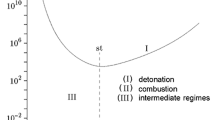Abstract
Additional data on parameters of detonation of monofuel components that ensure positive energy release during decomposition are reported. Being added to a combustible mixture, such substances can initiate the development of instabilities directly on the detonation wave front. In this case, energy release in the mixture proceeds in two stages. Both the basic and bifurcation structures arise in a jump-like manner (spontaneously), which disagrees with the hypothesis of gradual enhancement of weak perturbations usually used in numerical simulations of cellular structures.
Similar content being viewed by others
References
A. A. Vasil’ev, “Cell Size as the Main Geometric Parameter of Multifront Detonation Wave,” J. Propuls. Power 22(6), 1245–1260 (2006).
A. A. Vasil’ev, “Dynamic Parameters of Detonation,” in Shock Wave Science and Technology Reference Library, Vol. 6: Detonation Dynamics, Ed. by F. Zhang (Springer, 2012), pp. 213–279.
H.-N. Presles, D. Desbordes, M. Guirard, and C. Guerraud, “Gaseous Nitromethane and Nitromethane-Oxygen Mixture, a New Detonation Structure,” Shock Waves, No. 6, 111–114 (1996).
J. Luche, H.-N. Presles, and D. Desbordes, “Influence of Ar Dilution on Detonation Regime in H2-NO2/N2O4 Mixtures,” in Proc. of the 20th ICDERS (Montreal, Canada, 2005), CD ROM.
A. A. Vasil’ev, A. A. Moletotov, and A. V. Trotsyuk, “On a Two-Size Cellular Structure of Gas Detonation,” in Proc. XIII Symposium on Combustion and Explosion, Chernogolovka (2005), CD-ROM.
A. A. Vasil’ev and A. V. Trotsyuk, “Multi-Scaled Cellular Structure of Gaseous Detonation,” in 5 ISFS Proc. of the 5th Int. Seminar on Flame Structure, Novosibirsk, Russia, July 11–14, 2005, Ed. by O. Korobeinichev (Parallel Ltd., Novosibirsk, 2005), OPr-08, CD-ROM.
A. A. Vasil’ev and V. A. Vasiliev, “Ammonia: Detonation Hazards, Multi-structure,” in 4th European Combustion Meeting, Vienna University of Technology, April 14–17, 2009, Vienna/Austria, Book of Abstracts, p. 213 (see also CD-ROM).
A. A. Vasil’ev, V. A. Vasiliev, and A. V. Trotsyuk, “Bifurcation Structures in Gas Detonation,” Fiz. Goreniya Vzryva 46(2), 88–100 (2010) [Combust., Expl., Shock Waves 46 (2), 196–206 (2010)].
V. Guilly, B. Khasainov, H.-N. Presles, D. Desbordes, and P. Vidal, “Numerical Study of Detonation Cells under Non-Monotonous Heat Release,” in Proc. of the 20th ICDERS, Monreal, Canada, 2005, CD-ROM.
D. Desbordes and H.-N. Presles, “Multi-Scaled Cellular Detonation,” in Shock Wave Science and Technology Reference Library, Vol. 6: Detonation Dynamics, Ed. by F. Zhang (Springer, 2012), pp. 281–338.
A. A. Vasil’ev and A. V. Trotsyuk, “Self-Organization of Multifront Structure in Expanding Detonation Wave,” in 18th Int. Colloquium on the Dynamics of Explosions and Reactive Systems, July 29–August 03, 2001, Seattle, USA, Univ. Washington, CD-ROM, No. 001.
T. Fujiwara, A. Takasu, and T. Miyasaka, “Detonation Propagation in Variable Cross Section Channels,” in 18th Int. Colloquium on the Dynamics of Explosions and Reactive Systems, July 29–August 03, 2001, Seattle, USA, Univ. Washington, CD-ROM, No. 108.
A. A. Vasil’ev and A. V. Trotsyuk, “Experimental Investigation and Numerical Simulation of an Expanding Multifront Detonation Wave,” Fiz. Goreniya Vzryva 39(1), 92–103 (2010) [Combust., Expl., Shock Waves 39 (1), 80–90 (2003)].
T. Ichikawa and A. Matsui, “Study of Cell Width and Shock Pressure in Directly Initiated Spherical Detonation,” in Proc. of the 22nd ICDERS, Minsk, Belarus, 2009, CD-ROM.
V. A. Levin, I. S. Manuilovich, and V. V. Markov, “Excitation and Failure of Detonation in Gases,” Inzh.-Fiz. Zh. 83(6), 1174–1201 (2010).
V. I. Manzhalei and V. A. Subbotin, “Stability of an Overcompressed Gas Detonation,” Fiz. Goreniya Vzryva 12(6), 935–942 (1976) [Combust., Expl., Shock Waves 12 (6), 819–825 (1976)].
A. A. Vasil’ev, “The Quasi-Steady Regimes of Wave Propagation in Active Mixtures,” Shock Waves 18(4), 245–253 (2008).
D. Desbordes, F. Joubert, F. Virot, B. Khasainov, and H.-N. Presles, “Critical Tube Diameter in a Two Reaction-Steps Detonation: H2/NO2 Mixture,” in Proc. of the 21th ICDERS, Poitiers, France, 2007, CD-ROM.
A. N. Baratov et al., Fire and Explosion Hazard of Substances and Materials and Tools for Their Quenching: Reference Book (Khimiya, Moscow, 1990) [in Russian].
Author information
Authors and Affiliations
Corresponding author
Additional information
Original Russian Text © A.A. Vasil’ev.
__________
Translated from Fizika Goreniya i Vzryva, Vol. 50, No. 2, pp. 14–23, March–April, 2014.
Rights and permissions
About this article
Cite this article
Vasil’ev, A.A. Monofuel as a source of bifurcation properties of multifuel systems. Combust Explos Shock Waves 50, 135–143 (2014). https://doi.org/10.1134/S0010508214020038
Received:
Published:
Issue Date:
DOI: https://doi.org/10.1134/S0010508214020038




